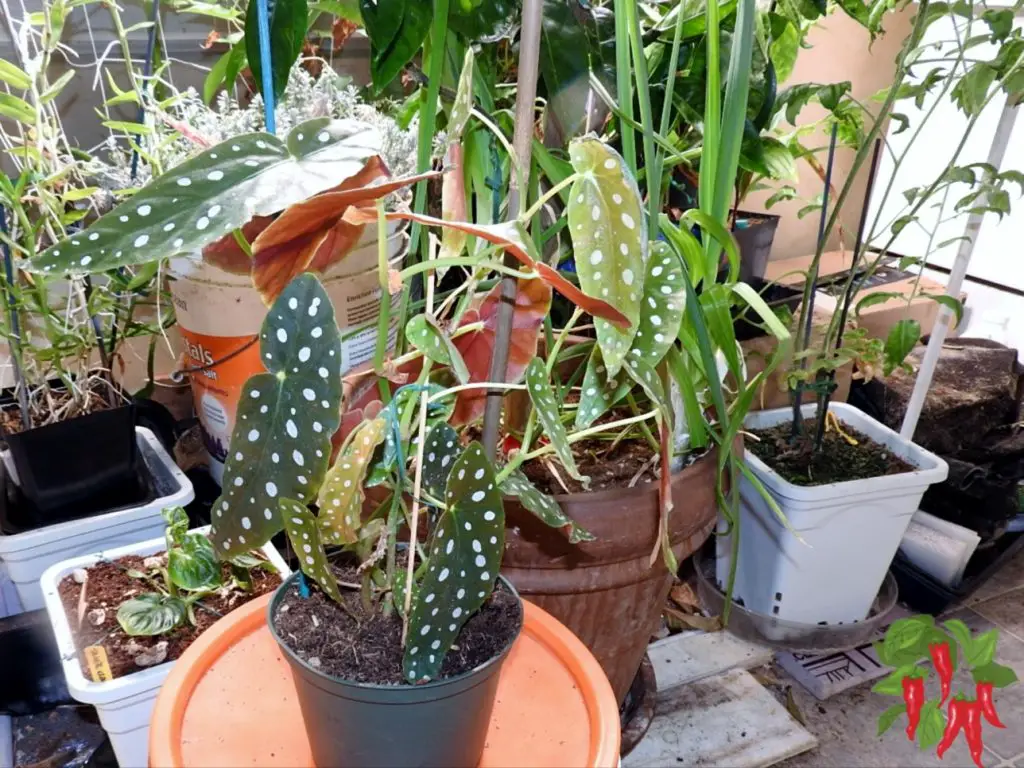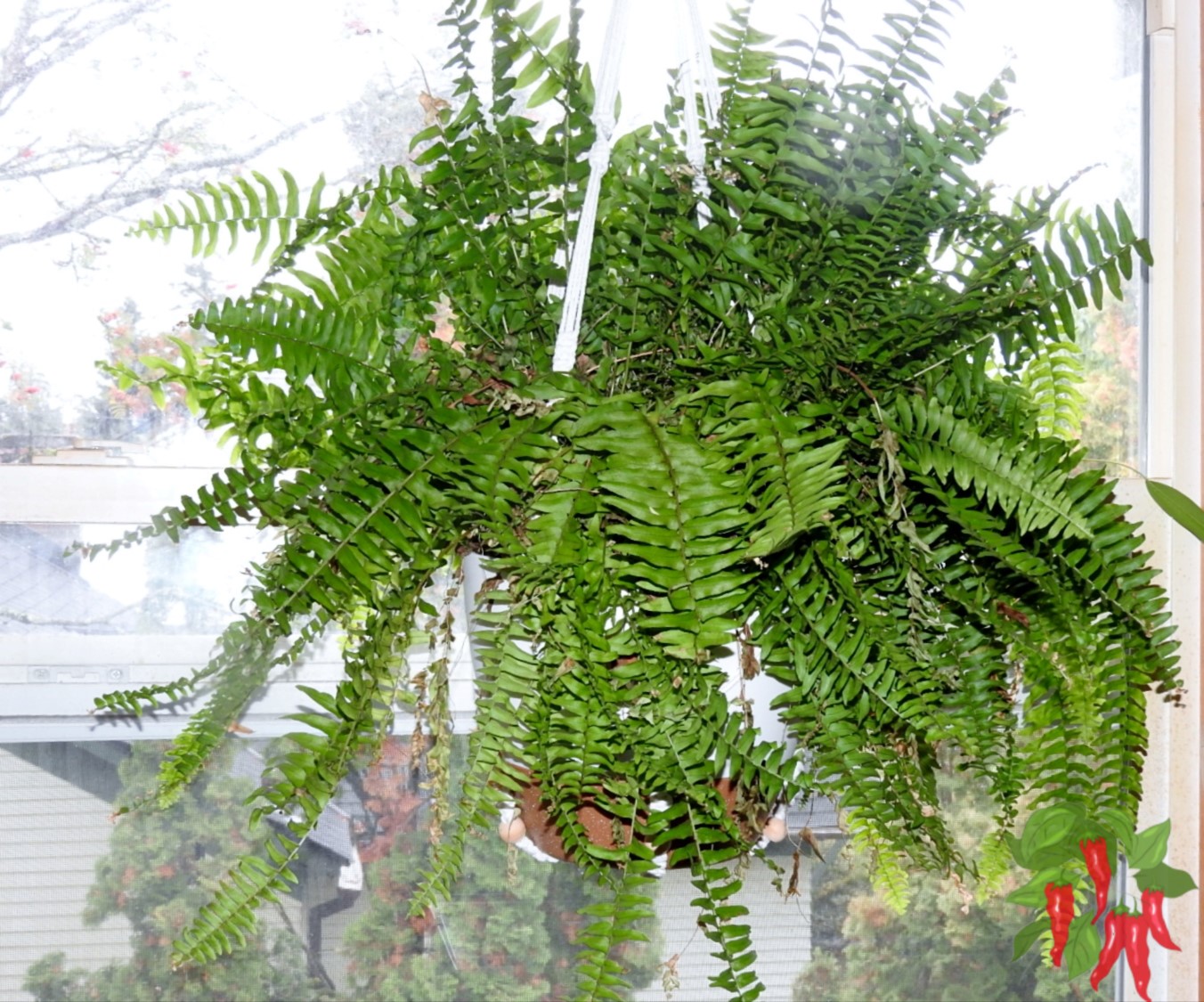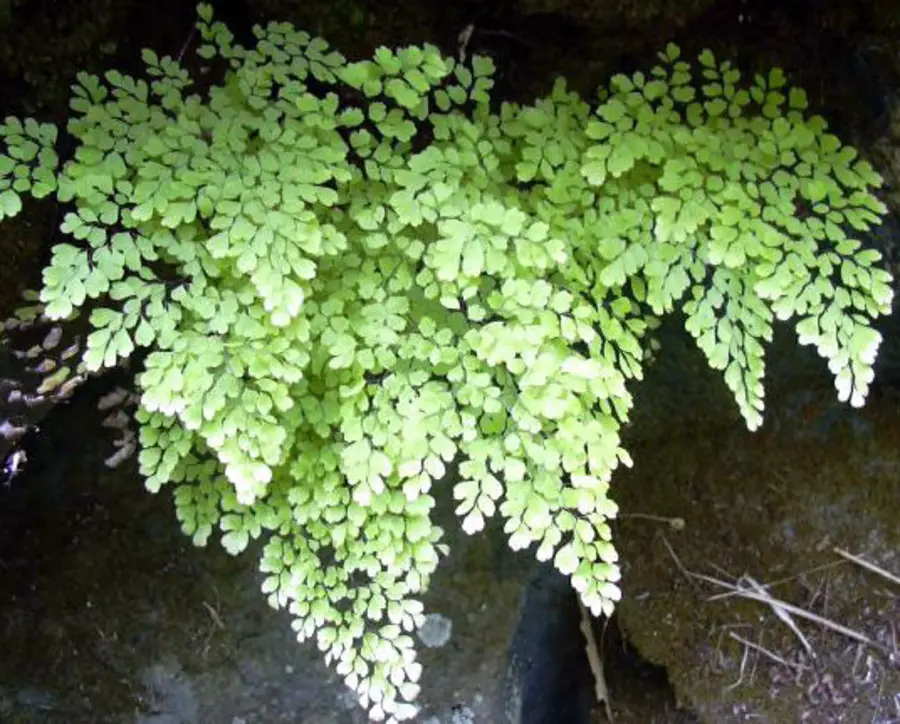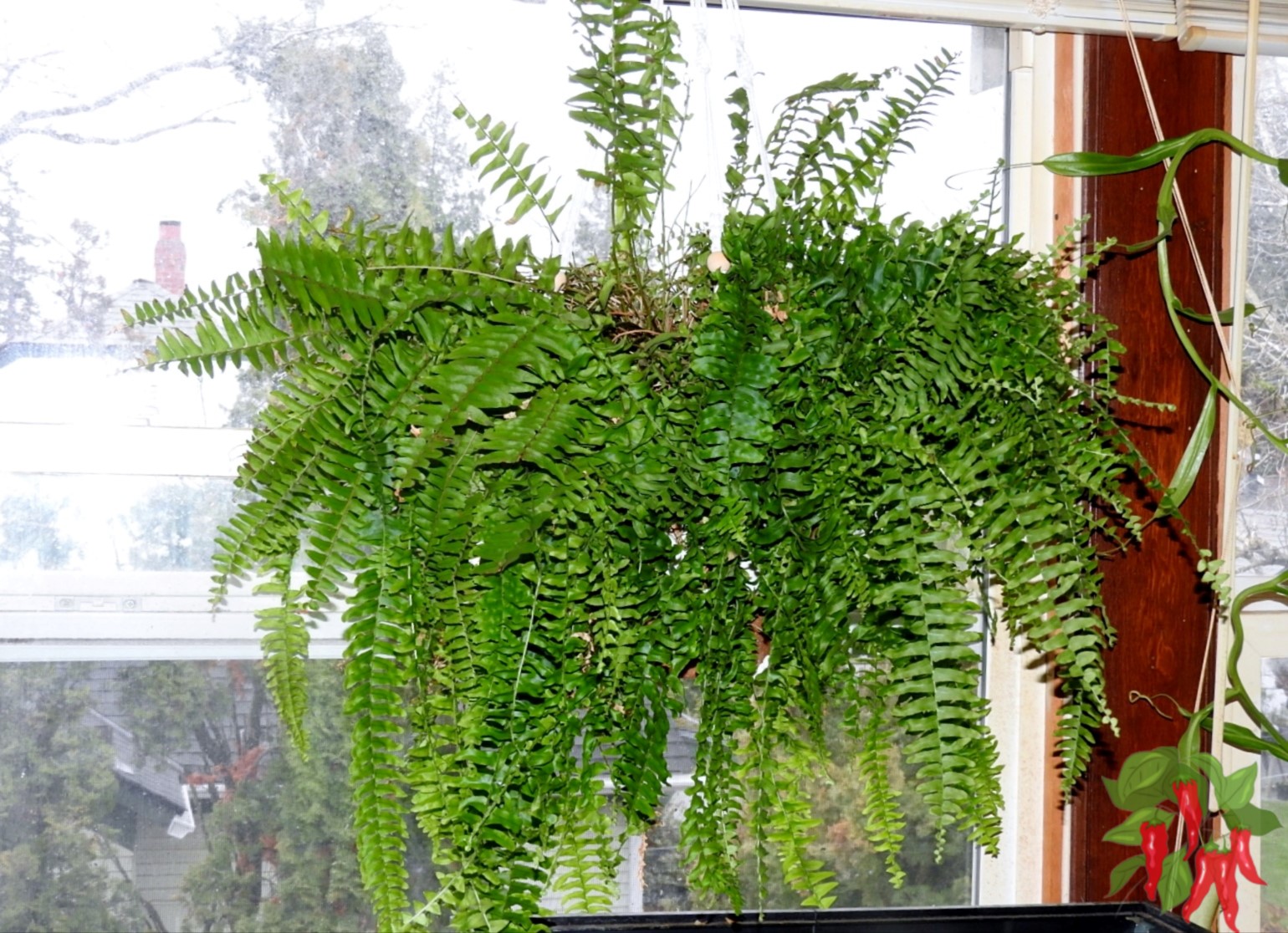This post contains affiliate links. If you buy something from one of our links we may earn a commission. Thanks

Begonia Maculata Care doesn’t have to be complicated! Discover simple tips to keep your polka dot plant thriving and those stunning spotted angel wing leaves looking their best.
Begonia Maculata Care Key Takeaways
- Begonia Maculata Care requires bright indirect light, well-draining soil, and humidity above 50%.
- Water when the top inch of soil feels dry, maintain temperatures between 65-75°F.
- Fertilize monthly during growing season.
- Keep away from direct sunlight and cold drafts for best results.
Begonia Maculata Plant Care Reference Guide:
| Characteristic | Details |
|---|---|
| Common Name | Begonia Maculata, Polka Dot Begonia |
| Botanical Name | Begonia maculata |
| Native Habitat | Tropical rainforests of Brazil |
| Plant Type | Perennial evergreen |
| Growth Pattern | Upright, bushy growth with wing-shaped, spotted leaves |
| Mature Size | 12–24 inches tall and wide indoors; can grow larger in optimal conditions |
| Watering | Keep soil consistently moist but not soggy; water when top inch dries |
| Light/Sun Exposure | Bright, indirect light; avoid direct sunlight to prevent leaf scorch |
| Soil Type | Well-draining potting mix with organic matter |
| Soil pH | Slightly acidic to neutral (6.0–7.0) |
| Temperature | 65–75°F (18–24°C); avoid drafts and temperatures below 60°F (15°C) |
| Humidity | High humidity; thrives in 50–70% or higher |
| Bloom Time & Flower Color | Spring and summer; clusters of small white flowers with yellow centers |
| Potential Problems | Brown edges (low humidity), yellowing leaves (overwatering), pests like spider mites or mealybugs |
| Repotting | Every 1–2 years or when roots outgrow the pot |
| Hardiness Zones (USDA) | Zones 10–12 (typically grown as a houseplant outside these zones) |
Begonia Maculata Care: Your Complete Guide
Welcome to the world of the stunning Begonia Maculata! Also known as the Polka Dot Begonia, Angel Wing Begonia or Spotted Begonia, this eye-catching houseplant has captured the hearts of plant enthusiasts worldwide with its distinctive silver-spotted leaves and deep red undersides.
Begonia Maculata care might seem tricky at first, especially when you’re trying to keep those stunning silver spots bright and beautiful.
Those eye-catching polka dot leaves and deep red undersides are total showstoppers, but without the right know-how, they can quickly lose their luster.
Don’t worry though – I’ve got all the secrets to help your Spotted Begonia thrive and keep those gorgeous leaves looking their absolute best.
Whether you’re new to growing this beauty or looking to enhance your care routine, this guide will help you master the art of keeping your Begonia Maculata thriving.
You can get your Begonia Maculata on Amazon here.
 Begonia Maculata – 6” from California Tropicals
Begonia Maculata – 6” from California Tropicals
Understanding Begonia Maculata
The Begonia Maculata is a fascinating tropical plant native to the rainforests of Brazil. With its unique polka-dotted leaves, dramatic burgundy undersides, and bamboo-like stems, it’s no wonder this plant has become a social media sensation.
These cane-type begonias can grow up to 4-5 feet tall indoors, making them perfect statement pieces for any room. Their angel-wing shaped leaves and occasional clusters of delicate white flowers add to their charm.
Standard Care Guidelines
Ready to unlock the secrets of keeping your Begonia Maculata happy and healthy? Let’s dive into the five essential elements that make these stunning plants thrive.
While each aspect of care plays a crucial role, you’ll find that once you get into a routine, caring for your polka dot beauty becomes second nature.
I’ve broken down everything you need to know about light, water, soil, temperature, and feeding into simple, actionable steps that will help your plant flourish.
Light Requirements
Proper lighting is crucial for maintaining those stunning silver spots on your Begonia Maculata.
These plants thrive in bright, indirect light that mimics their natural habitat beneath the rainforest canopy.
Too much direct sunlight can scorch the leaves, while insufficient light leads to dull spots and reduced growth. Position your plant near an east or north-facing window for optimal results.
Watering Practices
Finding the right watering balance is key to keeping your Begonia Maculata happy.
These plants prefer consistent moisture but are sensitive to overwatering. Allow the top inch of soil to dry between waterings, and always check the soil moisture with your finger before adding more water.
Water thoroughly until it drains from the bottom, but never let the plant sit in standing water.
Soil Preferences
Creating the perfect soil environment helps your Begonia Maculata thrive. Mix regular potting soil with perlite and orchid bark for optimal drainage and aeration.
The ideal ratio is 2 parts potting soil, 1 part perlite, and 1 part orchid bark. This mixture prevents root rot while providing the nutrients your plant needs.
A 75% coco coir and 25% perlite mix make a more sustainable potting mix than peat-based potting soil.
Using Coco Coir and Perlite Mix
Want to take your Begonia Maculata soil game to the next level? Try using coco coir as your base instead of traditional potting soil.
Mix 3 parts coco coir with 2 parts perlite for an excellent growing medium that offers superior drainage and aeration.
This combo has become a favorite among experienced growers because it helps prevent root rot while maintaining just the right amount of moisture.
The coco coir retains water without becoming waterlogged and naturally resists fungal growth, while perlite creates essential air pockets for healthy roots.
If you choose this mix, remember you’ll need to fertilize more frequently since coco coir doesn’t contain nutrients like regular potting soil does.
For best results, add a slow-release fertilizer when potting, and supplement with liquid fertilizer during the growing season.
Temperature and Humidity
As tropical plants, Begonia Maculatas enjoy warm temperatures between 65-75°F (18-24°C). They thrive in humidity levels above 50%. Consider using a humidifier, pebble tray, or grouping plants together to increase moisture in the air. Avoid placing your plant near drafts or air conditioning vents.
Fertilization
Support healthy growth by feeding your Begonia Maculata regularly during the growing season. Use a balanced, water-soluble fertilizer diluted to half strength every 2-3 weeks from spring through fall. Reduce fertilization in winter when growth naturally slows.
Advanced Care Considerations
Got the basics down? Fantastic! Now let’s level up your Begonia Maculata game with some pro techniques that’ll transform your plant from simply surviving to absolutely thriving. These next-level care tips focus on pruning, propagation, and keeping pests at bay – three skills that’ll help you grow a fuller, healthier plant and even expand your collection.
Pruning Techniques
Pruning is essential for maintaining a bushy, healthy Begonia Maculata. Regular trimming encourages fuller growth and helps manage the plant’s size. Cut back leggy stems just above a leaf node using clean, sharp scissors. The best time to prune is during the growing season, typically spring and summer, when the plant can quickly recover and produce new growth.
Propagation Methods
One of the most rewarding aspects of growing Begonia Maculata is how easily it propagates. Take 4-6 inch stem cuttings with at least two nodes, remove the lower leaves, and place them in water or moist potting mix. Keep the cuttings warm and humid, and you’ll see roots developing within 2-3 weeks. Once roots are established, transfer water-propagated cuttings to soil.
Pest and Disease Management
Prevention is the best strategy for keeping your Begonia Maculata healthy. Regularly inspect leaves for common pests like mealybugs and spider mites. If you spot any issues, treat them immediately with neem oil or insecticidal soap. Good air circulation and proper watering habits help prevent fungal problems like powdery mildew.
Repotting
Knowing when and how to repot your Begonia Maculata can make a huge difference in its growth and health. These plants typically need repotting every 18-26 months, or when you notice roots peeking through drainage holes. Choose a pot just 1-2 inches larger than the current one – too big of a jump can lead to overwatering issues. Spring is the ideal time to repot, as your plant is entering its active growth phase and can recover quickly from the move.
When repotting, gently remove the plant from its container, loosen the root ball carefully, and place it in fresh soil at the same depth it was growing before. Water thoroughly after repotting, but wait a few weeks before fertilizing to give those roots time to settle into their new home. If you notice dramatic leaf dropping after repotting, don’t panic – it’s normal for Begonia Maculata to have a brief adjustment period.
Beyond the Basics: Lesser-Known Insights
Seasonal Care Adjustments
Your Begonia Maculata’s needs change with the seasons. During winter, reduce watering frequency and hold off on fertilizing. Move plants away from cold windows and maintain consistent temperatures. In spring, gradually increase watering and resume regular feeding as growth picks up.
Encouraging Blooming
While Begonia Maculata is primarily grown for its stunning foliage, it can produce lovely white flowers under the right conditions. Provide bright indirect light, maintain proper humidity, and feed regularly during growing season to encourage blooming. Don’t be disappointed if flowers are sparse – the beautiful leaves are the main attraction.
Styling and Display Ideas
These stunning plants work beautifully as standalone specimens or grouped with other tropical plants. Place them on plant stands, shelves, or hanging baskets where their distinctive leaves can be admired. Choose decorative pots that complement your decor while ensuring proper drainage.
Caring for a Begonia Maculata FAQs
Caring for a Begonia Maculata brings up many common questions. Here are straightforward answers to your most pressing concerns about keeping these beautiful plants healthy and thriving.
Q. How do you care for a Begonia Maculata indoors?
A. Provide bright indirect light, maintain 50%+ humidity, water when the top inch of soil feels dry, and keep temperatures between 65-75°F. Feed monthly during growing season and use well-draining soil in a pot with drainage holes.
Q. How much light does Begonia Maculata need?
A. These plants thrive in bright, indirect light for 6-8 hours daily. Morning sun is fine, but protect them from harsh afternoon rays that can burn their leaves.
Q. Where is the best place to put a Polka Dot Begonia?
A. Place near an east or north-facing window, or a few feet back from a south-facing window with filtered light. Avoid cold drafts and heat vents.
Q. Do polka dot begonias like direct sunlight?
A. No, direct sunlight can burn the leaves. They prefer bright, filtered light that mimics their natural habitat under the rainforest canopy.
Q. Can begonias take full afternoon sun?
A. No, afternoon sun is too intense and can scorch the leaves. If you must use a south or west-facing window, use a sheer curtain to filter the light.
Q. How to make Begonia maculata bushier?
A. Regularly pinch back growing tips and prune leggy stems just above a node. This encourages branching and creates a fuller plant. Ensure adequate light to prevent stretching.
Q. Do begonia maculata like to be root bound?
A. They prefer to be slightly root bound rather than planted in too large a pot. Repot only when roots are visible through drainage holes, choosing a pot just 1-2 inches larger.
Q. Should begonias be watered from the top or bottom?
A. Top watering is best as it helps flush out mineral buildup. Water the soil directly, avoiding the leaves to prevent fungal issues. Bottom watering can work but shouldn’t be the only method.
Q. How to fix a leggy begonia maculata?
A. Prune back long, sparse stems to a node where you’d like new growth to appear. Increase light exposure and reduce fertilizer. Consider rotating the plant regularly for even growth.
Q. Should I stake my begonia maculata?
A. Yes, staking helps support tall stems and prevents breakage as the plant grows. Use bamboo stakes or decorative supports, securing stems loosely with plant ties or soft twine.
Q. Why are my Begonia Maculata’s leaves turning yellow?
A. Usually due to overwatering or poor drainage. Check soil moisture and ensure the pot has drainage holes.
Q. How often should I repot my Begonia Maculata?
A. Every 1-2 years, or when roots start growing through drainage holes.
Q. Why are the leaf spots fading?
A. Insufficient light is usually the cause. Move to a brighter location, avoiding direct sun.
Conclusion
Success with Begonia Maculata comes from understanding its needs and providing consistent care. While they may seem demanding at first, these stunning plants become easier to care for once you establish a routine.
Related Topics
• Understanding Different Begonia Types
• Creating the Perfect Indoor Humidity
• Decorating with Tropical Plants
• Natural Pest Control Methods
Key Takeaways
• Bright indirect light is crucial for maintaining spotted patterns
• Well-draining soil prevents root problems
• High humidity supports healthy growth
• Regular pruning encourages bushier plants
• Consistent care routines lead to success
• Prevention is key for pest and disease management
Remember, every plant is unique, and it may take some time to find the perfect care routine for your specific situation. With patience and attention, your Begonia Maculata will reward you with stunning foliage and healthy growth for years to come.
🌤️ Best Indirect Sunlight Plants
Looking for houseplants that thrive without direct sun? Explore these guides on the best plants and care tips for low to medium light spaces!
- 🌿 Best Indirect Sunlight Plants (Pillar Guide)
- 🌱 Dracaena Golden Heart Care
- 🍃 Begonia Maculata Care
- 🌸 How to Grow Hoya Krimson Queen
- 🪴 Caring for Shade-Loving Plants
- 🔍 How to Identify Plants that Thrive in Indirect Sunlight
- 🐍 Rattlesnake Plant Care
- 🌿 How to Care for Monstera
- 💛 How to Care for Golden Pothos
- 🎨 How to Care for Calathea
- 🌱 How to Care for Dieffenbachia
- ✌️ How to Care for Peace Lily
- 🖤 How to Care for ZZ Plant
- 🪟 Container Gardening for Limited Light
- 💡 Decorating Dim Corners & North-Facing Spaces
- 🌼 How to Grow Peperomia
- See all articles in our Indirect Sunlight Plants category
Related Content
Visit my Amazon Influencer Page for videos and gardening products Grow Your Own Garden






